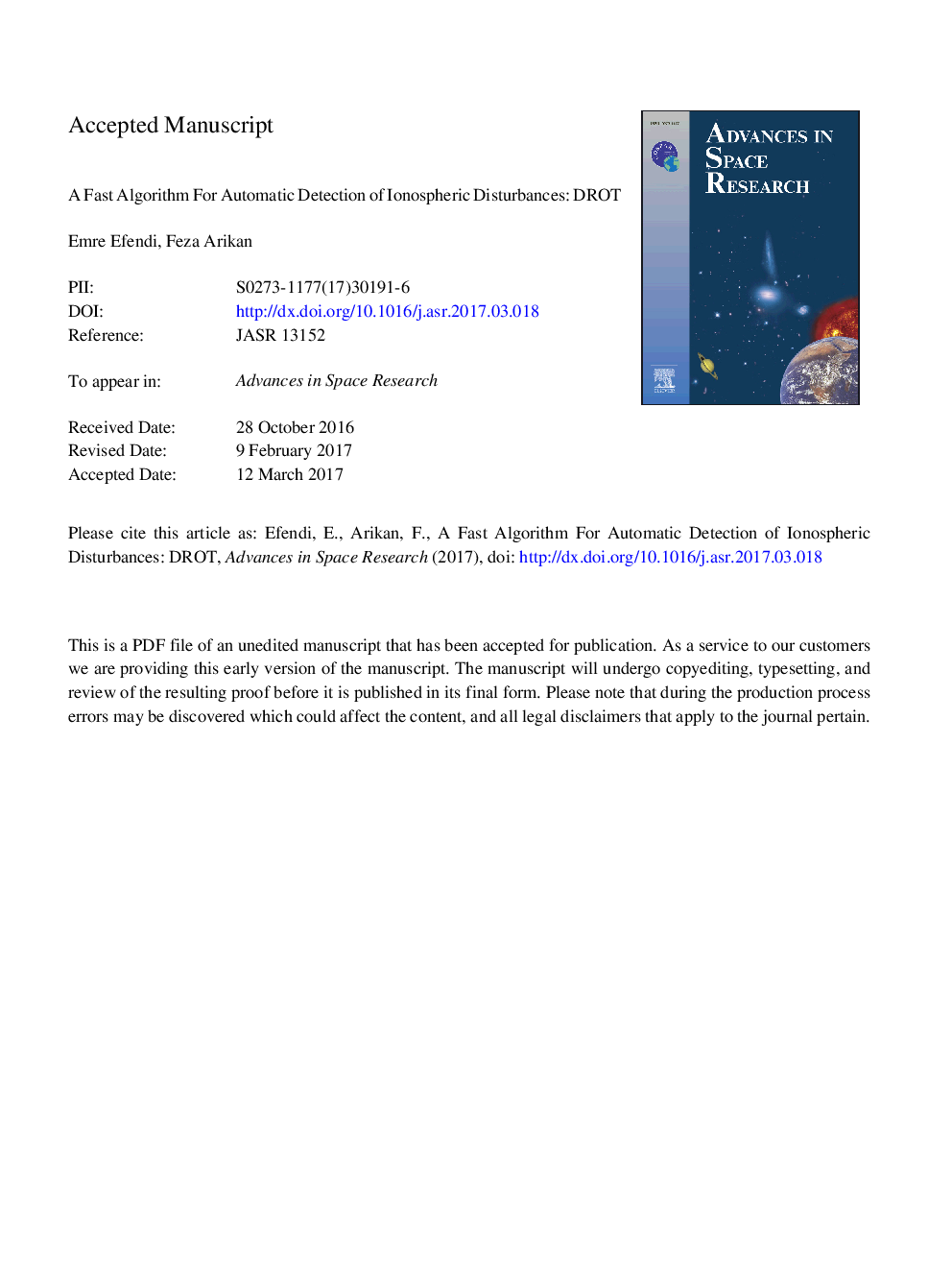| کد مقاله | کد نشریه | سال انتشار | مقاله انگلیسی | نسخه تمام متن |
|---|---|---|---|---|
| 5486649 | 1399471 | 2017 | 29 صفحه PDF | دانلود رایگان |
عنوان انگلیسی مقاله ISI
A fast algorithm for automatic detection of ionospheric disturbances: DROT
دانلود مقاله + سفارش ترجمه
دانلود مقاله ISI انگلیسی
رایگان برای ایرانیان
کلمات کلیدی
موضوعات مرتبط
مهندسی و علوم پایه
علوم زمین و سیارات
علوم فضا و نجوم
پیش نمایش صفحه اول مقاله

چکیده انگلیسی
Solar, geomagnetic, gravitational and seismic activities cause disturbances in the ionospheric region of upper atmosphere that may disrupt or lower the quality of space based communication, navigation and positioning system signals. These disturbances can be categorized with respect to their amplitude, duration and frequency. Typically in the literature, ionospheric disturbances are investigated with gradient based methods on Total Electron Content (TEC) data estimated from ground based dual frequency Global Positioning System (GPS) receivers. In this study, a fast algorithm is developed for the automatic detection of the variability in Slant TEC (STEC) data. STEC is defined as the total number of electrons on the ray path between the ground based receiver and GPS satellite in the orbital height of 20,000Â km. The developed method, namely, Differential Rate of TEC (DROT), is based on Rate of Tec (ROT) method. ROT is widely used in the literature and it is usually applied to Vertical TEC (VTEC) that corresponds to the projection of STEC to the vertical direction along the ray path at the Ionospheric Pierce Point (IPP) using a mapping function. The developed DROT method can be defined as the normalized metric norm between the ROT and its baseband trend structure. In this study, the performance of DROT is determined using synthetic data with variable bounds on the parameter set of amplitude, frequency and duration of disturbance. It is observed that DROT method can detect disturbances in three categories. For DROT values less than 50%, there is no significant disturbance in STEC data. For DROT values between 50% and 70%, a medium scale disturbance can be observed. For DROT values over 70%, severe disturbances such as Large Scale Traveling Ionospheric Disturbances (LSTIDs) can be observed. DROT method is highly sensitive to the amplitude of the wave-like oscillations. For a disturbance amplitude as low as 1.01 TECU, the disturbances that have durations longer than or equal to 20Â min and frequencies higher than 1.095Â mHz; or frequencies higher than 0.511Â mHz and durations longer than 55Â min can be detected automatically with DROT values of 50%. When DROT method is applied to midlatitude STEC values for disturbed days, it is observed that DROT method can detect the disturbances in near-real time, even if the GPS data from the station is uploaded with 15Â min intervals.
ناشر
Database: Elsevier - ScienceDirect (ساینس دایرکت)
Journal: Advances in Space Research - Volume 59, Issue 12, 15 June 2017, Pages 2923-2933
Journal: Advances in Space Research - Volume 59, Issue 12, 15 June 2017, Pages 2923-2933
نویسندگان
Emre Efendi, Feza Arikan,